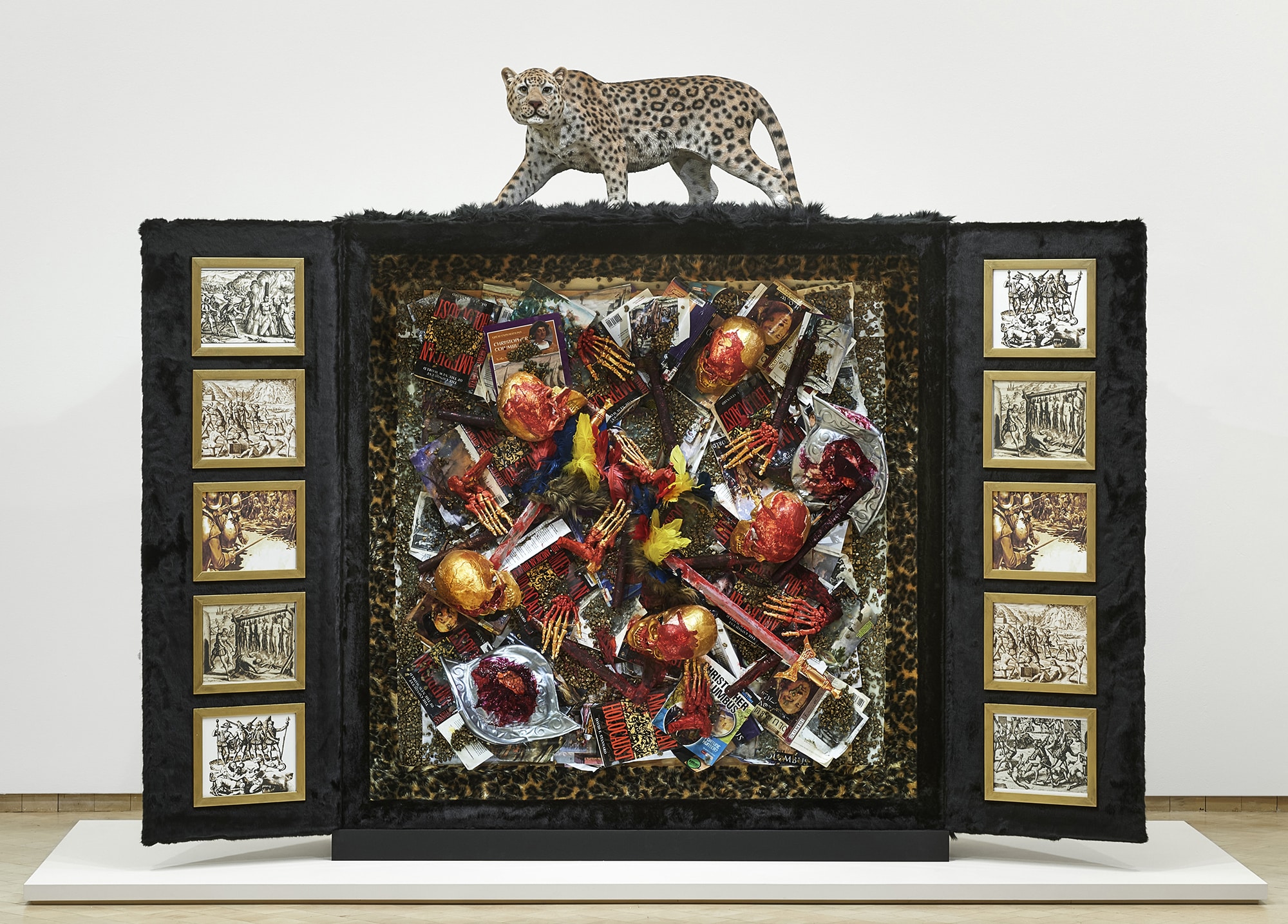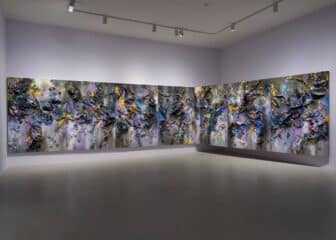
Genesis and Apocalypse in Raphael Montañez Ortiz’s “The Memorial…”

The ancient art process was a transformative process; it wasn’t a show, it wasn’t entertainment.
– Raphael Montañez Ortiz1
Mortality is the spark that animates The Memorial… (2019-2020), a mixed-media assemblage by Brooklyn-born, Puerto Rican artist Raphael Montañez Ortiz (b. 1934). First exhibited at El Museo del Barrio in late 2020 at the artist’s request following the outbreak of the COVID-19 pandemic, mass death is the critical framework that the viewer is asked to consider via an aesthetic rendering of the early Spanish conquest of the “New World.” Imagery housed in a trifold display case containing the dubious origins of Western modernity—bloodstained and gilded into existence by a combination of greed, disease, and depravity alluded to in the assemblage’s full title (see photo caption).
Accordingly, the historical record appears stacked and sequential—a visual cue that emphasizes the weight of this violent and recurring inheritance as a central theme of the work. Human remains feature prominently in what amounts to a makeshift burial site, dipped in blood and gold and framed in animal skins. It includes, among other things, the severed limbs of Taíno people punished for failing to collect sufficient tribute to meet the impossible quotas first mandated by Christopher Columbus. Violence, for which the artist has long been known through his ritualized destruction of objects such as pianos, sofas, or mattresses, is nonetheless archaeological, consisting of complicated and overlapping colonial genealogies that must be unearthed amid such entropic ruin.2
The written record is also buried or layered into the middle section of the assemblage as a bibliography of sorts through the inclusion of historical texts such as the 1992 book American Holocaust: Columbus and the Conquest of the New World by historian David E. Stannard, as well as Fray Bartolomé de las Casas’ firsthand account of the Spanish conquest published in 1552, Brevísima relación de la destrucción de las Indias (A Brief Account of the Destruction of the Indies); both of which are necessarily and essentially revisionist in scope, counternarratives to which the artist aligns the assemblage and his oeuvre, more broadly. The latter text is further represented in the wings on each side of the display by dramatic illustrations by Flemish artist Joos van Winghe (1544-1603), who faithfully renders the atrocities against the native population of the “New World” as described by the author, a Dominican friar.
The brutal imagery is framed in a nonlinear narrative sequence of repeating scenes that are stacked vertically, almost like film strips, recalling the experimental deconstructionist films that Montañez Ortiz began producing in the 1950s.3 Only the contemporaneous 1956 illustration by Robert C. Stanley (1918-96) entitled Untamed Women of the Amazon, which was published in For Men Only, an adventure-themed magazine that later switched its focus to pornography, is reproduced in the same position on the right and left flanks of The Memorial…, as if to establish the colonizer’s problematic, exoticizing gaze as a grounding constant, originating with the views espoused in the diaries and letters of Christopher Columbus. These writings also feature in the textual allusions embedded in the centerpiece of the assemblage. Together with the graveyard section, these scenes project an atemporal, dystopian cycle of oppression that was exceptionally relevant in the context of the pandemic, just as it was during the early conquest given the repeating threat of contagion, mass graves, forced or essential labor, and so on.
Cataclysm is another throughline to consider, for many Indigenous people experienced European colonization as divine retribution, an apocalypse euphemistically rendered through a Western lens as contact between the “New World” and the “Old World.” Similarly, the pandemic ushered in a world in which contagion became a sort of final judgment: for some, there were mild or nonexistent symptoms—while for others, particularly racialized and impoverished populations, COVID-19 was a death sentence or a protracted illness. Returning to the exaggerated title of the work and imagery employed, this entrenched, eurocentric mythology obscures the sacrifice of millions of Indigenous peoples and enslaved Africans, along with their languages, cultures, histories, etc., and establishes the basis for a social imaginary that prefers the abstraction of geographical divide and cultural exchange to the stark reality of systematic dehumanization and wealth extraction.
This dualistic narrative tension played out, again, on a global scale during the summer of 2020 following the police murder of George Floyd and subsequent protests against systemic racism and rampant state violence. Suddenly, with heightened contrast amid an unprecedented historical reckoning, a resolution, indeed, another world, seemed to briefly appear on the horizon. Yet over time, the re-entrenchment of oppressive systems and the bureaucratic end to the pandemic (the World Health Organization declared the public health emergency over in May of 2023), proved how genesis and apocalypse coexist not as a matter of perspective or circumstance, but rather as a function of humanity’s (self-)destructive urge—indiscriminate, like a virus.4
One should also consider how monuments, many of them honoring colonial and racist historical figures, have since been removed or renamed, ostensibly, to reappraise and rectify centuries of historical erasure. The conventional monument, however, is largely performative, “celebrat[ing] national triumphs through heroic, self-aggrandizing icons,” unfortunately, as has been the toppling of such monuments, leaving the question of what will replace them.5 True liberation can be reciprocal; ideally, it involves the symbolic destruction or relinquishing of material inheritance or privilege–an act somewhat akin to the potlatch ceremony of the Kwakwaka’wakw people in the Pacific Northwest Coast of British Columbia, Canada, which the artist experimented with extensively for his Potlatch series (2018–20).6 These twenty-five low reliefs share the same portal-like form as the middle section of The Memorial…, with a fake fur lining and an aerial view of the destruction contained within, i.e. a literal flattening of history and the process documenting it. The broad, multimodal concept of the potlatch, moreover, hints at several possible interpretations, particularly in reference to the artist’s claim of the assemblage as his “final work, my Guernica.” 7 Even in acknowledging death or inheritance the potlatch is healing, reciprocal, and life-affirming. Of course, it also reasserts social status. Montañez Ortiz, now 91, utilizes The Memorial… a playful gesture to the institution that is self-referential, yet instructive for preserving its legacy.
In The Memorial…, a statue of a jaguar sits atop the assemblage like a sentry—a totem of sorts—that allows the artist to figuratively put himself in the work via a native species deeply embedded in the mythic iconography of the continent, particularly among Mesoamerican cultures in which the jaguar is able to transit between life and death.8 A shedding of the human form to embody an animal spirit also suggests a performance that aligns with the artist’s enduring interest in the shamanic. This therianthropic act would have constituted a serious crime under the Spanish Inquisition, beginning with the emblematic case of Indigenous shaman Martín Ocelotl. Witnesses testified that Ocelotl, whose true name derives from the Nahuatl word for jaguar, was able to transform at will into his namesake, leading to his banishment to Spain—a strategy of containment (quarantine) to subdue his outsized influence in early colonial society.9 It also underscores allusions to legal frameworks of the Spanish conquest. Fray Bartolomé de las Casas, for example, participated in the infamous Valladolid Debates (1550-51), which sought to ascertain the humanity—or lack thereof—of the indigenous inhabitants of Abya Yala.
Ultimately, if culture is an object and a history (with some aesthetic assembly required), then The Memorial… broadly functions as what James E. Young terms a “counter-monument,” a concept that began as an aesthetic response by younger artists in late twentieth-century Germany attempting to reconcile their relative distance—both chronological and experiential—from the Holocaust. In this case, the adoption of an anti-monumental approach allows the artist to “express subjects and meanings not represented in traditional monuments” and bridge a wider gulf of over five hundred years of history and erasure.10 This is, fundamentally, a transformative act: to recreate the past in such a way that it prioritizes the urgency of alternative futures.
- Lauren Raine, “Physio-Psycho-Alchemy: The Art of Rafael Montañez Ortiz,” Coreopsis: A Journal of Myth and Theatre 6, no. 2 (Autumn 2017), Society for Ritual Arts, societyforritualarts.com/coreopsis/autumn-2017-issue/portfolio-item/848/. ↩︎
- John Vincler, “How to Decolonize a Museum? Try an Ax” The New York Times, August 7, 2022, https://www.nytimes.com/2022/07/28/arts/design/raphael-montanez-ortiz-el-museuo-del-barrio.html. ↩︎
- Chon A. Noriega, “Sacred Contingencies: The Digital Deconstructions of Raphael Montañez Ortiz,” Art Journal 54, no. 4 (1995): 36–40, https://doi.org/10.2307/777692. ↩︎
- Michael Duff, “WHO Chief Declares End to COVID-19 as a Global Health Emergency,” UN News, May 5, 2023, https://news.un.org/en/story/2023/05/1136367. ↩︎
- Shimrit Lee, “When We #TakeItDown, What Should Go Up?,” Monument Lab, 2021, https://monumentlab.com/bulletin/when-we-takeitdown-what-should-go-up. ↩︎
- An array can be viewed in Neal Buccino, “Mason Gross Professor Receives Honors From Three Major Arts Institutions,” Rutgers Today, January 6, 2021, https://www.rutgers.edu/news/mason-gross-professor-receives-honors-three-major-arts-institutions. ↩︎
- Buccino, “Mason Gross Professor Receives Honors.” ↩︎
- Isabel Bueno, “El jaguar, felino sagrado de Mesoamérica,” Historia National Geographic, 2023, https://historia.nationalgeographic.com.es /a/jaguar-felino-sagrado-mesoamerica_19716. ↩︎
- J. Jorge Klor de Alva, “Martín Ocelotl: Clandestine Cult Leader,” in Struggle and Survival in Colonial America, ed. David G. Sweet and Gary B. Nash (University of California Press, 1982), 128–41. ↩︎
- Ana Cristina Perry, “In Conversation: Raphael Montañez Ortiz with Ana Perry,” The Brooklyn Rail, July/August 2022, https://brooklynrail.org/2022/07/art/Raphael-Montaez-Ortiz-with-Ana-Perry/; Quentin Stevens, Karen A. Franck, and Ruth Fazakerly, “Counter-Monuments: The Anti-Monumental and the Dialogic,” The Journal of Architecture 17, no. 6 (2012): 952. ↩︎
Néstor David Pastor López is a New York City-based writer, editor, translator, and musician born and raised in Queens, with roots in Arequipa and Puerto Rico. For additional info and past work, please visit: www.ndpastor.com
Cite this essay: Néstor David Pastor López, “Genesis and Apocalypse in Raphael Montañez Ortiz’s The Memorial…” in X as Intersection: Writing on Latinx Art, October 29, 2025, accessed [DATE], https://uslaf.org/essay/genesis-and-apocalypse-in-raphael-montanez-ortizs-the-memorial/



